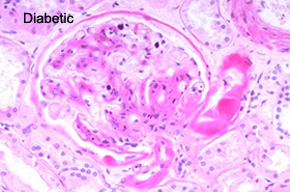|
|
|
Nutrition and Diagnosis-Related
Care
|
|
Her
kidneys are in real trouble. The
non-enzymatic glycosylation of the proteins of the arterioles
has led to interstitial tissue scaring and marked injury to the
glomeruli.
- Her creatinine clearance indicates she
has practically no kidney function left.
- With diabetes, all parts of the kidney
are damaged:
- Large vessels with advanced
atherosclerosis and small vessels with thickening of the theirs walls.
- Interstitial hypoxia leads to infections
and scaring.
- Glomerular basement membrane damage
leads to poor filtration, with retention of waste products and loss of
proteins.
- Roll the
cursor over the image.
|

Would a
normal glomerulus help? |
As the renal parenchyma goes, ancillary
jobs are not done, such as
- The production of erythropoietin (her
anemia is the result of this), and
- Electrolyte management: Na+
and K+ and phosphates.
- Don't forget, H+, it's an
electrolyte too. Renal failure leads to acidosis.
The total management is beyond the scope of
what we're doing, but here are the basics. |
|